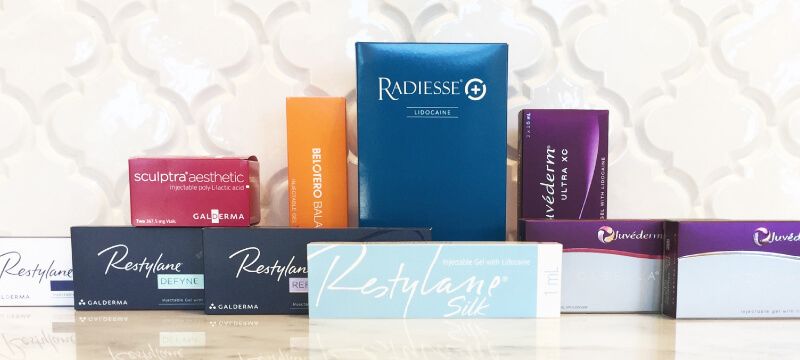Fat Transfer vs. Dermal Fillers: Which is Better?

Originally published on November 20, 2019. Updated on October 24, 2023.
Age-associated loss of facial volume is a result of a decrease in skin thickness, adipose/fat layer, muscle mass, and bone mass. By age 55, most people have lost up to 40% of the fat in their face. This volume loss leads to several aesthetic aging symptoms that become visually prominent including:
- the hollowness in the cheeks, temples, or under-eye areas
- development of lines and wrinkles
- sagging of the skin
- the decrease in the fullness of lips
- “bony” or “skeleton” appearance
- the decrease in width of the upper third of the face
Dermal fillers and fat transfer (fat grafting) have garnered significant attention for their ability to restore facial volume and smooth away even the most severe lines and wrinkles. While both treatments can provide similar results, each has unique benefits and drawbacks. In this comprehensive guide, we will discuss the intricacies of both dermal fillers and fat transfer procedures, providing critical points of differentiation to help patients make an informed decision based on their unique needs and preferences.
What are Dermal Fillers?
Dermal fillers are non-invasive cosmetic treatments that involve the injection of various substances into specific areas of the face to address volume loss, soften wrinkles, and enhance facial contours. These substances typically include hyaluronic acid, calcium hydroxylapatite, and poly-L-lactic acid, among others. The primary purpose of dermal fillers is to restore lost volume, contour the face, and diminish the appearance of fine lines and wrinkles.
There are many types of fillers, each with their own areas of use, benefits, and drawbacks. Common dermal fillers include Juvederm, Restylane, Sculptra, or Radiesse.
How Fillers Work
Dermal fillers work by replenishing the natural substances in the skin that have depleted over time, effectively adding volume and fullness to the treated areas. The injection process is relatively quick and simple, often completed within a single office visit, making it a popular option for those seeking immediate results without the need for surgery or extensive downtime.
Recovery
The recovery process for dermal fillers is generally minimal, with most patients experiencing only minor swelling, redness, or bruising at the injection sites. These side effects typically subside within a few days, allowing individuals to resume their regular activities including vigorous exercise soon after the procedure.
Results
Dermal fillers offer noticeable results immediately after the treatment, providing a more youthful and rejuvenated appearance. The treated areas appear plumper, smoother, and more contoured, contributing to a refreshed and natural look that can last anywhere from six months to two years, depending on the type of filler used and individual factors such as metabolism and lifestyle. Results can be maintained for an extended even further through periodic maintenance treatments.
The Advantages of Dermal Fillers
Dermal fillers present several advantages that make them a popular choice among individuals seeking facial rejuvenation:
- Immediate results: Dermal fillers offer instantaneous improvements, providing patients with a quick solution to address signs of aging and volume loss.
- Minimal recovery time: The short recovery period associated with dermal fillers allows individuals to resume their daily activities shortly after the procedure, making it a convenient option for those with busy schedules.
- Versatility: Dermal fillers can be used to target specific areas of the face, allowing for precise contouring and volumizing tailored to the patient’s unique aesthetic goals.
The Disadvantages of Dermal Fillers
While dermal fillers offer an array of benefits, it is crucial to consider the potential drawbacks associated with this cosmetic procedure:
- Temporary results: The effects of dermal fillers are not permanent, necessitating periodic touch-up treatments to maintain the desired results over time.
- Potential side effects: Although uncommon, some individuals may experience mild side effects such as swelling, redness, bruising, or in rare cases, allergic reactions to the filler substances.
- Cost accumulation: Given the temporary nature of the results, the cumulative cost of multiple treatment sessions over the years may become a consideration for individuals with long-term aesthetic goals.
What is Fat Transfer (Fat Grafting)?
Fat transfer, also known as fat grafting, is a cosmetic procedure that involves the extraction of fat from one part of the body through a liposuction procedure, followed by the purification and re-injection of the fat into targeted areas that require volume enhancement or rejuvenation.
How it works
The process of fat transfer begins with the gentle extraction of excess fat from areas such as the abdomen, thighs, or buttocks. After purification, the harvested fat cells are meticulously injected into specific regions of the face to restore volume, soften wrinkles, and improve overall facial contours.
Recovery
The recovery period for fat transfer is typically longer compared to that of dermal fillers, as the procedure involves both liposuction and subsequent injections. Thus, the recovery experience is very similar to liposuction recovery. Patients may experience swelling, bruising, and discomfort at both the extraction and injection sites, with the recovery period ranging from several days to a few weeks, depending on individual healing factors.
Results
Fat transfer yields natural-looking and long-lasting results, as the injected fat integrates seamlessly with the existing facial tissues, providing a more sustainable solution to facial volume loss and signs of aging. The results of fat transfer can last several years or even longer, with some patients experiencing permanent improvements in the treated areas.
The Advantages of Fat Transfer
Fat transfer offers several distinct advantages that make it an appealing option for individuals considering facial rejuvenation:
- Natural look and feel: As the procedure utilize the patient’s own fat cells, the results of fat transfer appear and feel natural, blending seamlessly with the surrounding tissues.
- Longevity of results: Unlike dermal fillers, fat transfer can provide longer-lasting outcomes, with the potential for permanent improvements in facial volume and contours.
- Reduced risk of allergic reactions: Since the procedure uses the patient’s own tissue, the risk of adverse reactions or rejection is minimal, making it a safer option for many individuals.
The Disadvantages of Fat Transfer
While fat transfer offers compelling benefits, there are several considerations to bear in mind before opting for this procedure:
- Variable absorption rates: Not all transferred fat will survive in the new location, leading to potential inconsistencies in the treated areas and the need for additional touch-up procedures to achieve the desired results.
- Prolonged recovery time: The extended recovery period associated with fat transfer may require patients to adhere to strict post-operative care guidelines to ensure optimal healing and results.
- Technique dependency: The success of fat transfer largely depends on the skill and expertise of the surgeon, emphasizing the importance of selecting a qualified and experienced professional to perform the procedure.
Fat Transfer vs. Dermal Fillers: A Detailed Comparison
Composition
Dermal fillers consist of various substances, including hyaluronic acid, calcium hydroxylapatite, and poly-L-lactic acid, among others, each with its unique properties and duration of effectiveness. In contrast, fat transfer utilizes the patient’s own fat cells, minimizing the risk of allergic reactions and promoting natural integration within the facial tissues.
Ideal candidates
Dermal fillers are often recommended for individuals seeking a temporary solution to address specific signs of aging or facial volume loss without the need for invasive procedures. On the other hand, fat transfer is suitable for individuals looking for a more natural and long-lasting solution to facial rejuvenation, particularly those who desire permanent results and a more comprehensive approach to facial contouring.
Results
Dermal fillers offer immediate and noticeable results that last for several months to a couple of years, depending on the type of filler used and individual factors. In contrast, fat transfer provides natural-looking and long-lasting results, with the potential for permanent improvements in facial volume and contours that can endure for several years or more.
How quick results are achieved
Dermal fillers yield immediate results, with patients noticing a visible improvement in facial volume and contours shortly after the procedure. Fat transfer, while offering a more gradual enhancement process, also provides noticeable improvements within a few weeks as the injected fat cells integrate and settle into the surrounding tissues.
Result duration (how long results last)
The results of dermal fillers typically last between 6 months to 2 years, depending on the type of filler used and individual factors such as metabolism and lifestyle choices. In contrast, fat transfer can provide long-lasting results, with some patients experiencing permanent improvements in facial volume and contours that endure for several years or more.
More than one treatment required?
Dermal fillers often require multiple treatments over time to maintain the desired results, as the effects of the fillers are not permanent and gradually diminish over several months. In contrast, fat transfer may necessitate only one or two procedures to achieve the desired outcome, with the potential for long-term or permanent improvements in the treated areas.
Invasiveness
Dermal fillers are minimally invasive, involving simple injections into the targeted areas of the face, making them a convenient option for individuals seeking immediate results without extensive downtime. In comparison, fat transfer is a slightly more invasive procedure, as it involves both liposuction for fat extraction and subsequent injections for volume enhancement, requiring a more extended recovery period and careful post-operative care.
Recovery
The recovery period for dermal fillers is relatively short, with most patients experiencing only minor swelling, redness, or bruising at the injection sites, allowing them to resume their regular activities shortly after the procedure. Fat transfer, on the other hand, entails a more prolonged recovery process, with patients potentially experiencing swelling, bruising, and discomfort at both the extraction and injection sites, requiring several days to weeks for complete healing.
Costs
The cost of dermal fillers varies depending on the type of filler used, the number of treatment sessions required, and the geographical location of the clinic. While the initial costs of fat transfer may be higher compared to dermal fillers, the potential for longer-lasting results and reduced need for multiple treatments over time may make it a cost-effective option for individuals with long-term aesthetic goals.
Which Is Best?
Both dermal fillers and fat transfer offer viable solutions for patients seeking to rejuvenate their appearance and restore facial volume. While dermal fillers provide immediate and temporary improvements, fat transfer offers a more natural and enduring approach to facial rejuvenation, with the potential for long-lasting or even permanent results. By understanding the unique benefits and limitations of each procedure and considering individual aesthetic goals, you can make an informed decision that suits your specific needs and preferences, ultimately achieving a more youthful and revitalized appearance that boosts your self-confidence.
When deciding between dermal fillers and fat transfer, it is crucial to consult with a qualified plastic surgeon or dermatologist who can provide personalized recommendations based on the patient’s unique aesthetic goals and medical history. An experienced provider will consider the unique needs and desires of each individual patient to choose the option that best aligns with their aesthetic aspirations and lifestyle.
